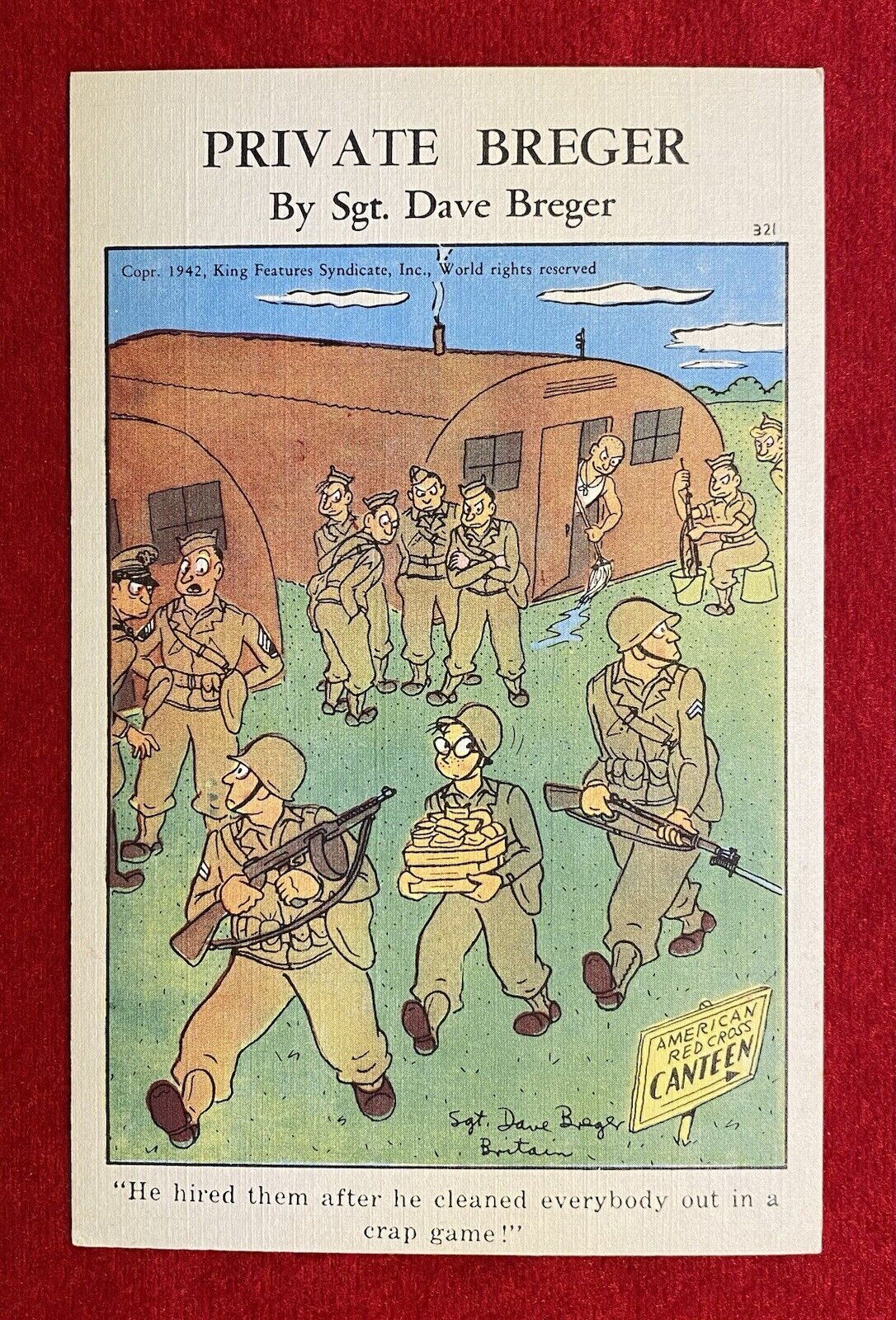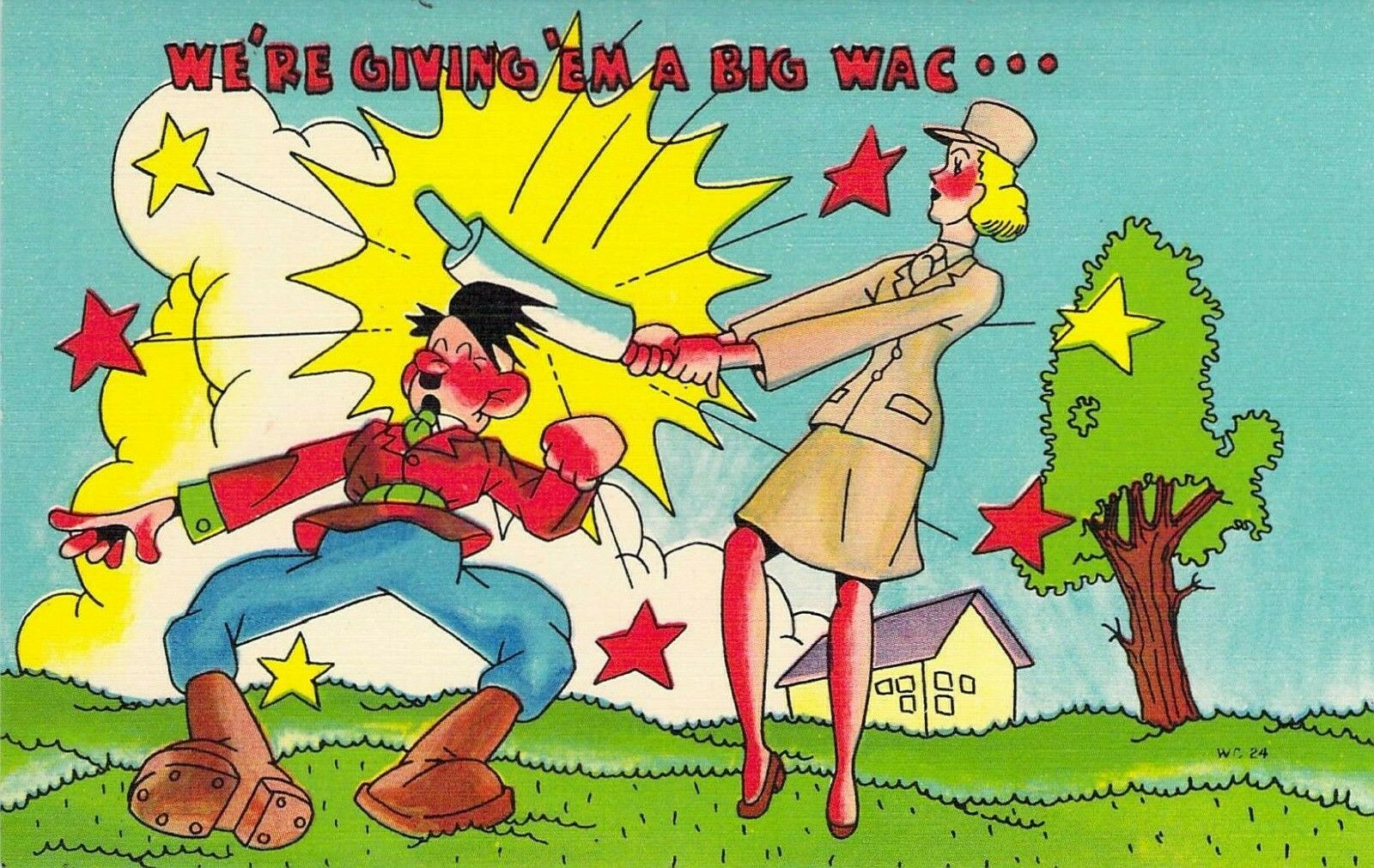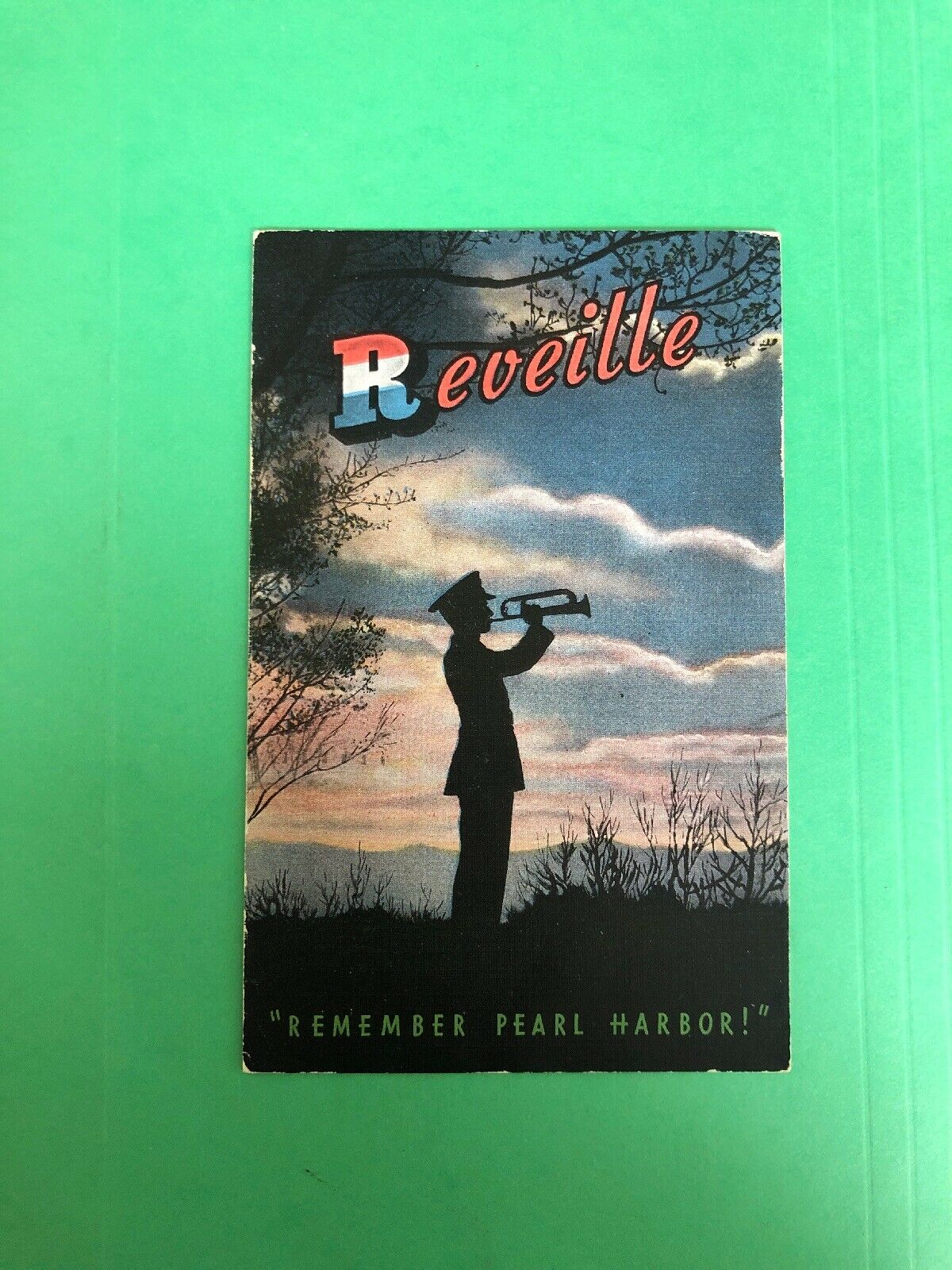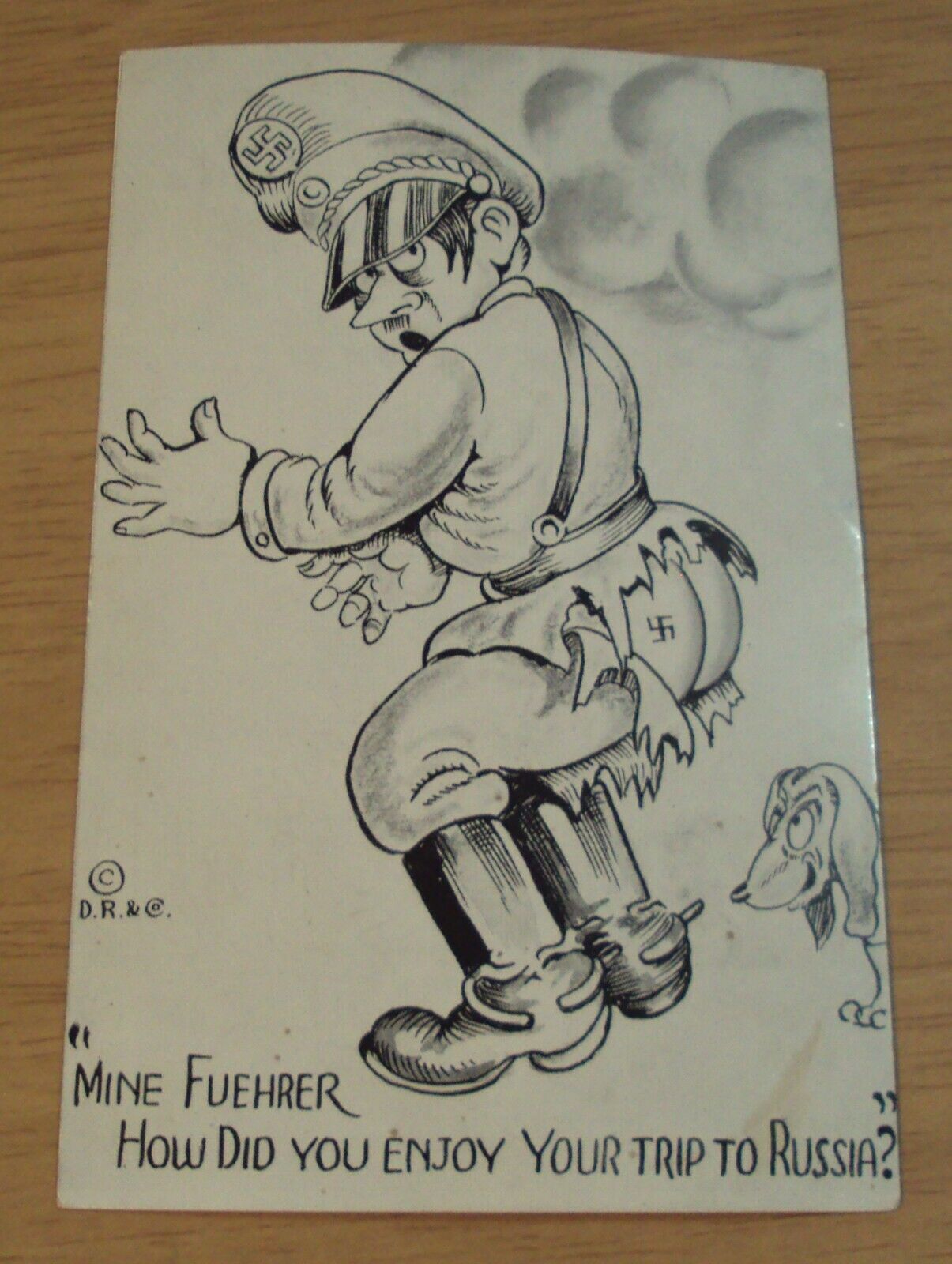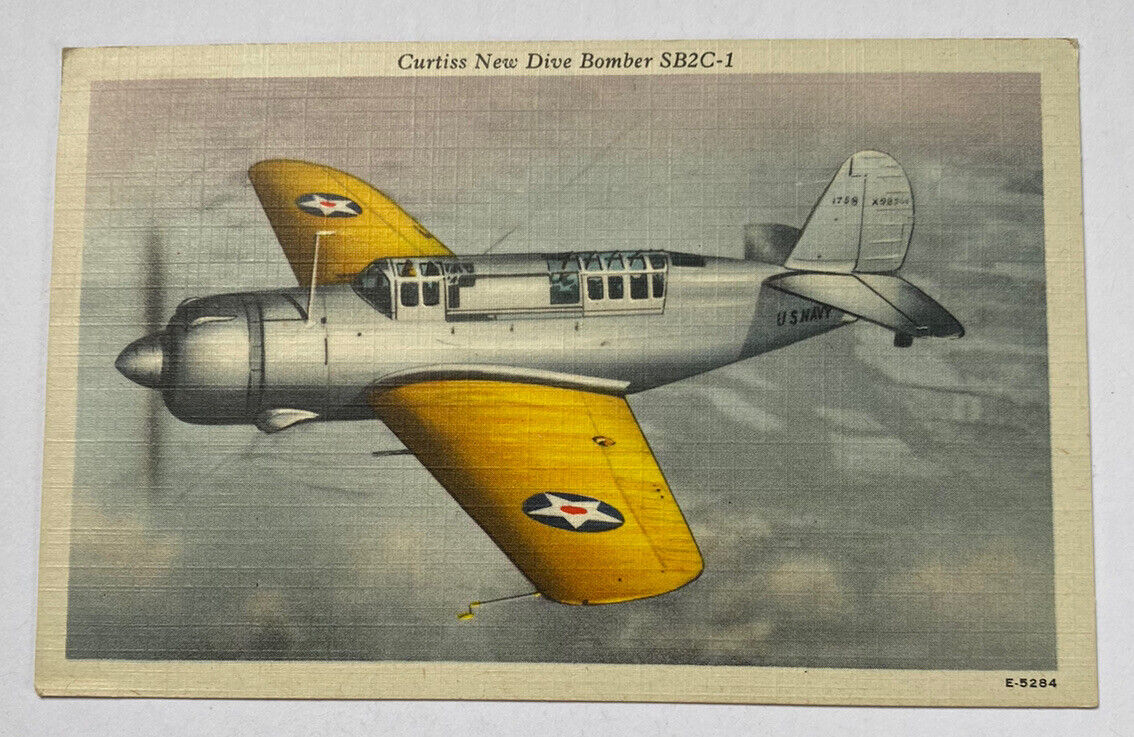-40%
1942 **WWII** ~PRIVATE BREGER~ COMIC (BY SGT. DAVE BREGER) U. S. ARMY POSTCARD!
$ 5.27
- Description
- Size Guide
Description
1942 ***WORLD WAR II*** "HE HIRED THEM AFTER HE CLEANED EVERYBODY OUT IN A CRAP GAME" MILITARY COMICS (BY AMERICAN CARTOONIST SERGEANT DAVID IRVING BREGER) UNITED STATES ARMY ... HUMOROUS "UNUSED" POSTCARD (NO. 321) ... COPYRIGHT 1942, KING FEATURES SYNDICATE INC.!(Approximated dimensions: 3 1/2" x 5 1/2").
Very crisp and clean!
___________________________________________________________________________________________________________
David Breger
Born
April 16, 1908
Died
January 16, 1970 (aged 61)
Nationality
American
Alma mater
Northwestern University
Occupation
Cartoonist
Military career
Allegiance
United States
Service/
branch
United States Army
Years of service
1941-1945
Unit
Special Services
division
Battles/wars
World War II
Irving David Breger
(April 15, 1908 – January 16, 1970) was an American
cartoonist
who created the syndicated
Mister Breger
(1945–1970), a
gag panel
series and
Sunday comic strip
known earlier as
Private Breger
and
G.I. Joe
. The series led to widespread usage of the term "G.I. Joe" during
World War II
and later.
[1]
Dave Breger
was his signature and the byline on his books. During
World War II
, his cartoons were signed
Sgt. Dave Breger
.
Early life
Growing up in
Chicago
, where he was born of native Russian parents, butcher Benjamin Breger and Sophie Passin Breger, only a few weeks after they arrived in the United States from Ukraine. As a youth, Breger had encounters with the local gangsters while working at his father's sausage factory. In 1926, he acquired his high school diploma from Crane Technical School, where he drew cartoons signed
Irving Breger
for the school paper. He studied architectural engineering at the University of Illinois and then transferred to
Northwestern University
, where he edited the campus humor magazine,
Purple Parrot
, while studying pre-med and psychology. He had no schooling in art or cartooning, and his college cartoons were drawn in a style similar to
John Held, Jr.
[2]
Graduating from Northwestern in 1931 with a degree in abnormal psychology, he spent a year traveling the world, visiting Russia and Africa; during that period he sold cartoons to the German magazine,
Lustige Blätter
. He returned to Chicago and the sausage stockyard, rising to the position of office manager of his father's firm, where he devised the company slogan, "Our Wurst Is the Best". His first marriage, with fashion model Evelyn Breger, lasted five years.
[2]
In 1937, after receiving a check from
The Saturday Evening Post
, Breger arrived in New York and began freelancing to
Collier's
,
Parade
,
This Week
,
Esquire
,
Click
and
The New Yorker
.
World War II
Dave Breger's World War II,
Private Breger
postcard #306. Caption: "That soldier's here, Sir, about a new paratrooper uniform to deceive the enemy."
Early in 1941, he was drafted into the
United States Army
and sent to
Camp Livingston
in Louisiana, where he repaired trucks. He drew at night in the bakery or while sitting in a truck with netting overhead to keep the bugs away.
The Saturday Evening Post
, under the heading
Private Breger
, began publishing these cartoons as a series starting August 30, 1941.
[1]
[2]
The Army became aware of his talent and transferred him to the
Special Services Division
in New York, where he married Brooklyn-born art agent Dorathy Lewis on January 9, 1942.
[3]
In the early spring of 1942, he was assigned to the New York staff of
Yank, the Army Weekly
.
[2]
[4]
Yank
wanted Breger to do cartoons like those in
The Saturday Evening Post
, but the editors asked him to devise a new title. He came up with the title
G.I. Joe
from the military term "Government Issue", and the character's full name was Joe Trooper. His
G.I. Joe
cartoon series began in the first issue of
Yank
(June 17, 1942). That summer, Breger arrived in the UK in 1942 as one of the first two
Yank
correspondents, covering the American military in England as a photo-journalist, while also producing his weekly
G.I. Joe
cartoon for
Yank
.
[2]
King Features Syndicate
took an interest and signed Breger on to do a
Private Breger
(aka
Private Breger Abroad
) daily panel for domestic distribution. It was launched October 19, 1942 and continued until October 13, 1945.
[2]
He soon became one of the most famous and widely read of the World War II cartoonists, and the term "G.I. Joe" was adopted first by soldiers and then the homefront as the popular term for the American foot soldier. (Hasbro's
G.I. Joe
is a different character, developed by
Larry Hama
and trademarked as "G.I. Joe, A Real American Hero.") In 1942, Breger illustrated the sheet music for
Irving Berlin
's "I Left My Heart at the Stage Door Canteen".
[5]
G.I. Jerry
Breger also produced
G.I. Jerry
, satirical cartoons about
Hitler
and others in the
Nazi
regime. There also was a
postcard
series titled
Private Breger
.
[6]
The character remained a private throughout World War II, while Breger himself was promoted through the ranks to corporal, sergeant and eventually lieutenant. His August 25, 1945 cartoon was signed
Lt. Dave Breger
, indicating his final military rank. From 1943 to 1946,
Private Breger
was reprinted in
David McKay
's
Ace Comics
(1943–46) and
Magic Comics
(1945).
Mister Breger
Dave Breger's
Mister Breger
(1945–1970) was originally
Private Breger
during WWII.
Returning to civilian life after World War II, Breger also had his character become a civilian. Private Breger was discharged, and on October 22, 1945, the title was altered from
Private Breger
to
Mister Breger
. The
Mister Breger
Sunday strip
was added on February 3, 1946. Vacationers could write friends with the set of
Mister Breger
postcards,
Mister Breger on Vacation
.
[7]
Recurring themes in the strips and panels included jail, weddings and Breger employed as a bank teller. In one cartoon, Breger predicted that since television showed so many old movies, the day would come when movie theaters would turn to vintage television for product. This prediction came true with the advent of such TV-based films as
Mission: Impossible
and
Star Trek
.
Mister Breger
also received comic book reprints in
The Katzenjammer Kids
(1947),
Popeye
(1967),
Beetle Bailey
(1969) and
Flint Comix and Entertainment
(2009–10).
In 1946, Breger became a founding member of the
National Cartoonists Society
. Dave and Dorathy Breger settled in
West Nyack, New York
, where they had three children—Dee, Lois and Harry. They were, according to Breger, "all three artistic".
[3]
In the 1960s, Breger taught a cartooning course at New York University, developing his lesson plans into a book,
How to Draw and Sell Cartoons
(1966).
When Breger died in 1970, he was cremated at Ferncliff Cemetery in
Hartsdale, New York
.
Mister Breger
continued to run as a daily panel until March 21, 1970. The final Sunday was published the following day, two months after his death.
Books
Between 1942 and 1951, Breger did five books collecting his Army cartoons.
Private Breger in Britain
(1944), published in London by Pilot Press Ltd., included an introductory discussion on Anglo-American humor between Breger and Michael Barsley.
Squads, Write
was a 1951 postcard book with 32 cards printed 6
1
⁄
2
" × 11" on postcard quality paper.
In
But That's Unprintable
(1955) Breger wrote about newspaper and magazine taboos and illustrated his text with 135 unpublished cartoons by leading cartoonists, including
Bo Brown
,
Milton Caniff
,
Irwin Caplan
, Eric Ericson,
Stan Fine
,
Rube Goldberg
,
Leo Garel
,
Don Flowers
, Phil Interlandi,
Reamer Keller
, Fred Lundy,
Jack Markow
, Charles E. Martin,
Fred Neher
,
Russell Patterson
,
Mort Walker
and
George Wolfe
. The material is arranged in such chapters as bodily functions, clothing, death, mental illness, sex and words.
Awards and exhibitions
Northwestern University honored him in 1946 with an Alumni Merit Award for distinguishing himself in his field of endeavor. An exhibition of Breger cartoons,
WWII and Private Breger
, was displayed at
Syracuse University
's Ernest S. Bird Library from February 28 to April 6, 1979.
Syracuse University Library's Special Collections Research Center has Breger's papers (more than 90 items of correspondence) plus 2,414 of his cartoons, including 377 of the World War II cartoons. There is also a collection at the Library of Congress.
[8]
___________________________________________________________________________________________________________
We strive to find rare and unusual vintage pieces to match up with your special collection.
Returns are readily accepted is the item(s) is the same as described. Item(s) must be in the exact condition as delivered. Buyer pays return shipping.
Items .00 or more will be shipped with tracking. Items 0.00 or more will be shipped with insurance.
Combined shipping discount for multiple purchases (Please wait for us to send invoice for 2 or more items).
Please feel free to contact us with any questions or concerns.
Be sure to check out our "ever changing" inventory of vintage postage stamps, covers, postal cards, billheads, letterheads, stock certificates, bank checks, railroad and steamship ephemera, Civil War ephemera, World War I ephemera, World War II ephemera, Korean War ephemera, Vietnam War ephemera, promissory notes, automotive ephemera, fraternity ephemera, circus ephemera, jeweler and pocket watch ephemera, sports ephemera, vintage matchbooks, military memorabilia, badges, medals, pins and ephemera, vintage coins, vintage worldwide banknotes, vintage tokens, historical memorabilia and ephemera, vintage pens and pencils plus many other special items we can pass onto our customers.
Empire Stamp Company
INTERNATIONAL SHIPPING:USPS FIRST CLASS MAIL INTERNATIONAL/FIRST CLASS PACKAGE INTERNATIONAL SERVICE.
DELIVERY TIMES WILL VARY BY LOCATION FOR INTERNATIONAL BUYERS.
